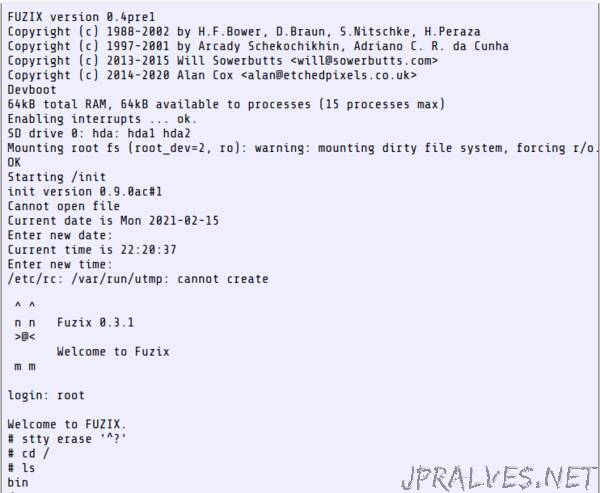
“So, my new Raspberry Pi Picos (two of them) arrived just as I was finishing up the ESP8266 Fuzix port, and naturally I had to port Fuzix to this too. I didn’t video this one, which is a shame as it would probably have been a more interesting watch.
The Pico is an interesting device: two Cortex M0+ cores running at approximately 130MHz, overclockable up to lots; 2MB of NAND flash on chip; 269kB of RAM; and a large collection of interesting hardware, including two high-speed IO coprocessors which allow you to do some really interesting things. The Fuzix port only uses one core but it runs really nicely on it, which RAM to spare. Compared to the ESP8266 it seems a little slower, but I haven’t touched the overclocking settings yet. Performance is still completely adequate for an interactive Unix.
Working with the Pico was an experience: the documentation is excellent, as is the C SDK. The SDK provides a set of libraries which are thin wrappers around the underlying hardware, making most features utter simplicity to use. Unlike the ESP8266’s libraries, the Pico SDK is unopinionated and doesn’t require you to use any of its features: if you want to talk directly to the hardware, you can (and in fact there’s library support for doing just this). There are some high-level features like a heap, stdio emulation, multicore primitives, etc which I’m not using, but if you don’t use them you don’t pay for them. For my embedded-systems brain it’s the ideal ratio of functionality to complexity. I wish more platforms provided libraries this good. Maybe we’ll get compatible ports of the Pico SDK to other systems; I can only hope.
There are some niggles, such as the almost non-negotiable requirement to use cmake as your build system. cmake is pretty ghastly but to be honest build systems are always terrible, and cmake’s not the worst choice. Once I nerved myself to trust it, it was a breeze to use and the Pico SDK’s cmake addons make building binaries and flashable images trivial.
Development was done using the Pico port of OpenOCD. I don’t have a JTAG debugger which will work on the Pico, but that’s fine, because there’s a turnkey image which will let you use a Pico as a JTAG debugger for a Pico! Which is why I bought two. And the debugger was written with the SDK, too…
So, the Fuzix port provides:
user binaries using up to 64kB of code and data each (this could be expanded, as there’s plenty of spare RAM)
up to 15 processes
a proper Unix filesystem
SD card support, used for both the filesystem and swap space
serial console on UART0
the full set of Fuzix core binaries work — fsck, Bourne shell, the standard Unix tools, a vi clone, etc, plus some simple games
What you don’t get:
NAND flash support: the code’s done, but I’ve discovered that a bad filesystem will crash the dhara FTL library. As the Pico’s flash is too small to use for swap, you have to have an SD card anyway, so I haven’t bothered fixing this.
Multitasking support: currently only the most recent process runs. Most things will work fine, with the big exception of pipes. This should work but doesn’t due to a bug.
an absence of bugs
Screenshots are kinda meaningless, but here’s a serial terminal dump. if this looks similar to the ESP8266 one, it’s because I’m doing all the same things.”
